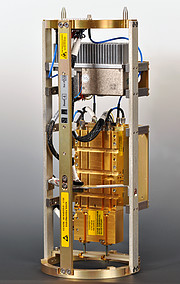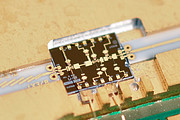Announcement
ALMA Telescope Upgrade to Power New Science
5 June 2012
Before its construction is even completed, the new telescope ALMA — the Atacama Large Millimeter/submillimeter Array — is embarking on an upgrade that will help astronomers investigate the earliest galaxies and search for water in other planetary systems. The oversight board for ALMA has authorised the design and building of an additional set of receivers with state-of-the-art performance, which will enable the telescope to access a part of the spectrum of light that it cannot currently study.
ALMA is the world’s largest astronomy project, and this powerful new facility on the Chajnantor plateau in Chile is giving astronomers insight into both how the Universe and its galaxies have evolved since the Big Bang, and how stars and planetary systems formed in our own galaxy. Although only half of its final total of 66 antennas are currently in place at the high-altitude site in northern Chile (see ann12035), ALMA is already operating and making scientific observations with a partial array (see for example eso1137 and eso1216).
ALMA observes the Universe in radio waves: light which is invisible to our eyes. Extremely weak signals from space are collected by the ALMA antennas and focussed onto the receivers, which transform the faint radiation into an electrical signal. The new “Band 5” receivers will be able to detect electromagnetic radiation with wavelengths between about 1.4 and 1.8 millimetres (211 and 163 gigahertz), one of the ranges of the spectrum to which Earth's atmosphere is partially transparent, which allows the light to reach the ALMA antennas.
The new receivers were originally designed, developed, and prototyped by Onsala Space Observatory’s Advanced Receiver Development group, based at Chalmers University of Technology in Gothenburg, Sweden, in collaboration with the Rutherford Appleton Laboratory, UK, and ESO, under the European Commission (EC) supported Framework Programme FP6 (ALMA Enhancement) starting in 2006. Six of these receivers have been built under the FP6 contract and supplied to ALMA (see ann1098).
Over the next five years, all 66 of ALMA’s antennas will be equipped with these new receivers. To do this, including spares, another 67 units need to be built. These will be provided by Europe with contributions from the United States. The European Southern Observatory (ESO) will place the European contract for the cryogenically cooled receivers, and oversee their development. The consortium leader will be NOVA, the research school for astronomy in the Netherlands. The receivers will be fabricated by NOVA in partnership with Onsala Space Observatory’s Advanced Receiver Development group. In North America, the National Radio Astronomy Observatory (NRAO) will build the high-precision oscillators that will tune the receivers, so that the output from all antennas can be precisely combined to make high-resolution images.
The receivers will be used to study some of the earliest galaxies in the Universe and will help us to understand when some of the first stars formed. They will also enhance astronomers' abilities to measure the presence of water — a molecule essential to life — in the dusty disks where planets are believed to form, and in the atmospheres of planets and comets in our own Solar System. Water in space can be tricky to measure accurately, because of the confusing effects of observing through the water vapour in Earth's atmosphere. The way in which ALMA's Band 5 receivers will measure water reduces some of these difficulties.
The decision to fund this enhancement of ALMA, even before the telescope is completed, was made by the ALMA Board in April 2012. On 9 May 2012, the decision was approved by ESO's Finance Committee. The upgrade is expected to be completed in 2016.
ALMA, an international astronomy facility, is a partnership of Europe, North America and East Asia in cooperation with the Republic of Chile. ALMA construction and operations are led on behalf of Europe by ESO, on behalf of North America by the National Radio Astronomy Observatory (NRAO), and on behalf of East Asia by the National Astronomical Observatory of Japan (NAOJ). The Joint ALMA Observatory (JAO) provides the unified leadership and management of the construction, commissioning and operation of ALMA.
Links
- More about ALMA at ESO
- The Joint ALMA Observatory
- NOVA, the research school for astronomy in the Netherlands
- Announcement from the Joint ALMA Observatory
Contacts
Hans Rykaczewski
ALMA Enhancement Programme Co-ordinator, ESO
Garching, Germany
Tel: +49 89 3200 6630
Email: hrykacze@eso.org
Douglas Pierce-Price
ESO ALMA Public Information Officer
Garching, Germany
Tel: +49 89 3200 6759
Email: dpiercep@eso.org
About the Announcement
| Id: | ann12042 |
Our use of Cookies
We use cookies that are essential for accessing our websites and using our services. We also use cookies to analyse, measure and improve our websites’ performance, to enable content sharing via social media and to display media content hosted on third-party platforms.
ESO Cookies Policy
The European Organisation for Astronomical Research in the Southern Hemisphere (ESO) is the pre-eminent intergovernmental science and technology organisation in astronomy. It carries out an ambitious programme focused on the design, construction and operation of powerful ground-based observing facilities for astronomy.
This Cookies Policy is intended to provide clarity by outlining the cookies used on the ESO public websites, their functions, the options you have for controlling them, and the ways you can contact us for additional details.
What are cookies?
Cookies are small pieces of data stored on your device by websites you visit. They serve various purposes, such as remembering login credentials and preferences and enhance your browsing experience.
Categories of cookies we use
Essential cookies (always active): These cookies are strictly necessary for the proper functioning of our website. Without these cookies, the website cannot operate correctly, and certain services, such as logging in or accessing secure areas, may not be available; because they are essential for the website’s operation, they cannot be disabled.
Functional Cookies: These cookies enhance your browsing experience by enabling additional features and personalization, such as remembering your preferences and settings. While not strictly necessary for the website to function, they improve usability and convenience; these cookies are only placed if you provide your consent.
Analytics cookies: These cookies collect information about how visitors interact with our website, such as which pages are visited most often and how users navigate the site. This data helps us improve website performance, optimize content, and enhance the user experience; these cookies are only placed if you provide your consent. We use the following analytics cookies.
Matomo Cookies:
This website uses Matomo (formerly Piwik), an open source software which enables the statistical analysis of website visits. Matomo uses cookies (text files) which are saved on your computer and which allow us to analyze how you use our website. The website user information generated by the cookies will only be saved on the servers of our IT Department. We use this information to analyze www.eso.org visits and to prepare reports on website activities. These data will not be disclosed to third parties.
On behalf of ESO, Matomo will use this information for the purpose of evaluating your use of the website, compiling reports on website activity and providing other services relating to website activity and internet usage.
Matomo cookies settings:
Additional Third-party cookies on ESO websites: some of our pages display content from external providers, e.g. YouTube.
Such third-party services are outside of ESO control and may, at any time, change their terms of service, use of cookies, etc.
YouTube: Some videos on the ESO website are embedded from ESO’s official YouTube channel. We have enabled YouTube’s privacy-enhanced mode, meaning that no cookies are set unless the user actively clicks on the video to play it. Additionally, in this mode, YouTube does not store any personally identifiable cookie data for embedded video playbacks. For more details, please refer to YouTube’s embedding videos information page.
Cookies can also be classified based on the following elements.
Regarding the domain, there are:
- First-party cookies, set by the website you are currently visiting. They are stored by the same domain that you are browsing and are used to enhance your experience on that site;
- Third-party cookies, set by a domain other than the one you are currently visiting.
As for their duration, cookies can be:
- Browser-session cookies, which are deleted when the user closes the browser;
- Stored cookies, which stay on the user's device for a predetermined period of time.
How to manage cookies
Cookie settings: You can modify your cookie choices for the ESO webpages at any time by clicking on the link Cookie settings at the bottom of any page.
In your browser: If you wish to delete cookies or instruct your browser to delete or block cookies by default, please visit the help pages of your browser:
Please be aware that if you delete or decline cookies, certain functionalities of our website may be not be available and your browsing experience may be affected.
You can set most browsers to prevent any cookies being placed on your device, but you may then have to manually adjust some preferences every time you visit a site/page. And some services and functionalities may not work properly at all (e.g. profile logging-in, shop check out).
Updates to the ESO Cookies Policy
The ESO Cookies Policy may be subject to future updates, which will be made available on this page.
Additional information
For any queries related to cookies, please contact: pdprATesoDOTorg.
As ESO public webpages are managed by our Department of Communication, your questions will be dealt with the support of the said Department.



